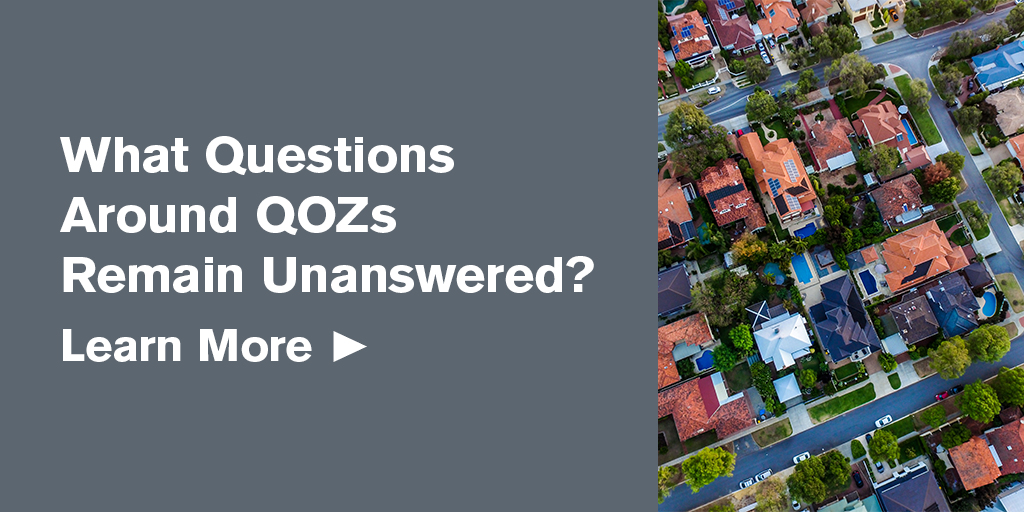Since Qualified Opportunity Zones (QOZs) were first introduced in 2017, we have received two sets of proposed regulations dealing with QOZs and there have been two formal Treasury Department hearings regarding these rules, as well as a couple of additional published guidance items issued.
While many questions have been answered, there still exist further questions and uncertainty. However, with the guidance we now have, Qualified Opportunity Zone Funds (QOZFs) are being formed and “the train has left the station.”
We have previously published two standalone releases on QOZs. The purpose of this article is to look at some of the remaining issues/uncertainties. The last Treasury hearing on QOZs was July 9. There will likely be no further hearings, and it is expected that final regulations will be issued, hopefully in the near future, although it is unclear whether there may be additional proposed regulations.
Here is some discussion around some, not all, of the remaining issues.
Section 1231 Gains
The existing regulations provide an investor must invest capital gains into a QOZF to achieve the desired tax benefits. The sale of trade or business assets (e.g., sale of rental real estate) is classified as Section 1231 gain. Section 1231 gain is treated as capital gain and the amount that can be invested in a QOZF is the net Section 1231 gain (after offsetting the gain by any Section 1231 losses for the year). Since the amount eligible for investment in a QOZF is the net Section 1231 gain, the investor has to wait until the end of the year to see what his / her net Section 1231 gain is. It appears the recapture of prior year Section 1231 losses would not impact the calculation of the net Section 1231 gain for the current year and thus the amount eligible for investment.
Further, the latest round of regulations indicates the 180 day investment period for such gain starts on the last day of the tax year. So, if you sold your rental apartment in February and generated $5 million of Section 1231 gain, your 180 day investment period does not start until December 31 of your tax year. Taxpayers who invested Section 1231 gains prior to the release of the second set of proposed regulations may find the investment does not qualify for QOZ benefits unless some relief is forthcoming.
The fact that a portion of the Section 1231 gain may be treated as Section 1250 unrecaptured depreciation gain should not change this favorable treatment. Section 1250 unrecaptured gain is still treated as capital gain but merely taxed at a higher tax rate (25%).
It is hoped that in the regulatory guidance to come, taxpayers would be given a choice to use either the 180 day period beginning on the realization date or the 180 day period beginning on the last day of the tax year.
Substantial Improvement Test
In order for a property to qualify as a Qualified Opportunity Zone Business Property (QOZBP), the original use of that property has to commence with the QOF or the QOF has to “substantially improve” the property. The question arises in the context of purchased property and whether the QOF can meet the substantial improvement test on an asset by asset basis or can the fund aggregate assets to meet the test. The preamble to the regulations indicates the test is on an asset by asset basis. So, if you purchased a 10 building apartment complex, on one land parcel, you would have to meet the substantial improvement test on each of the 10 separate buildings rather than meeting the test in the aggregate. If you made no improvements to three of the buildings, but spent sufficient amounts on the remaining buildings to meet the test on each of those buildings, you would only have seven of the 10 buildings that would be QOZBP. If you were allowed to aggregate all 10 buildings, then the entire project would qualify.
It is hoped that in the guidance to come some reasonable aggregation would be allowed. For example, in the real estate context, aggregation should be allowed if the property (the 10 building apartment complex above) operates as an integrated unit (as evidenced by management, financing, and general operations, etc.).
Valuing a Carried Interest
A partnership interest received for services (a carried interest or a profits interest) is not a qualifying interest in a QOZF. If a partner has a mixed investment (e.g., a capital interest and a carried/profits interest), the allocation percentages are calculated, for the profits interest, based on the highest share of the residual profits the partner would receive with respect to that interest. With respect to any remaining interests, the percentage interest for the capital interests is based on the relative capital contribution attributable to the qualifying investment. For example, if a partner has a 5% capital interest with a 10% carried/profits interest and the capital partners have an 8% preferred return, the proposed regulations appear to say that two-thirds of the partner’s interest is not qualifying. More clarification is needed around these types of interests. Perhaps, partners in this situation should consider holding any carried/profits interests separate from their capital interests.
31 Month Working Capital Safe Harbor
The 2019 regulations clarify a Qualified Opportunity Zone Business (QOZB) that needs more than 31 months to comply with its written plan does not lose QOZ benefits if the delay is caused by waiting for government action where the application was completed within 31 months. Many believe this extension provision should apply to other circumstances beyond the QOZB’s control, like weather conditions, natural disasters, supply shortages, labor stoppages, etc. Also, it is not entirely clear how the 31-month period applies. Does the 31-month period pause for any time there is a government delay or does the government action need to be pending at the end of the 31 months for this provision to apply?
Triple Net Leases
To qualify as a QOZB, there has to be an active trade or business. A triple net (NNN) lease does not rise to the level of an active trade or business, and therefore, a NNN lease property would not qualify for QOZ benefits.
Generally, a NNN lease has the tenant paying property taxes, insurance and maintenance. But, what happens under these rules if the lessor pays one of the three of these expenses and is involved in some management/oversight? Also, what happens if some portion of a project is NNN leased and the remainder is not?
Leases should be reviewed to determine whether the terms would actually be considered NNN under current law.
Gain on Sale of Assets – Prior To and After the 10 Year Holding Period
A QOF cannot sell its assets prior to holding them for 10 years without recognizing gain. Such sales are taxable events. Treasury does not believe the statute gives them authority to provide for non-recognition.
However, there is a new provision in the latest set of regulations that may provide some relief in the context of a QOF’s sale of its assets after a 10-year hold period. Now a QOF can sell its assets (primarily interests in project entities) after a 10-year hold and have the gain exclusion apply. If the taxpayer has held the interest in the QOF for at least 10 years, then the taxpayer may make the election to exclude the capital gains on such disposition from the qualifying investment.
Summary
Other uncertainties exist, but the hope is when the final regulations are issued, there will be more clarity around more of the open questions. In the meantime, we have received enough guidance to allow for QOZF formations and for investors to begin investing.
Jackie Matsumura is a Partner and Real Estate Industry Group Co-leader at BPM. Contact Jackie at [email protected] or 925-296-1035.
Greg Dresdow is a Senior Tax Advisor in the Real Estate Industry Group at BPM. Contact Greg at [email protected] or 925-296-1088.
 Since Qualified Opportunity Zones (QOZs) were first introduced in 2017, we have received two sets of proposed regulations dealing with QOZs and there have been two formal Treasury Department hearings regarding these rules, as well as a couple of additional published guidance items issued.
Since Qualified Opportunity Zones (QOZs) were first introduced in 2017, we have received two sets of proposed regulations dealing with QOZs and there have been two formal Treasury Department hearings regarding these rules, as well as a couple of additional published guidance items issued.

